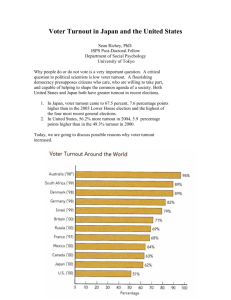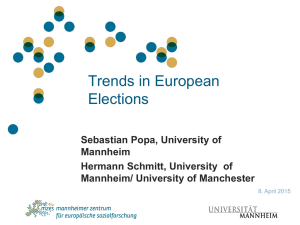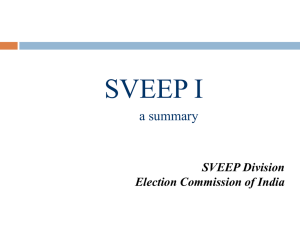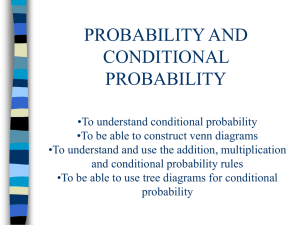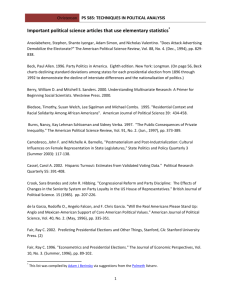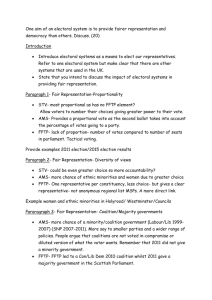Elections: Turnout
advertisement
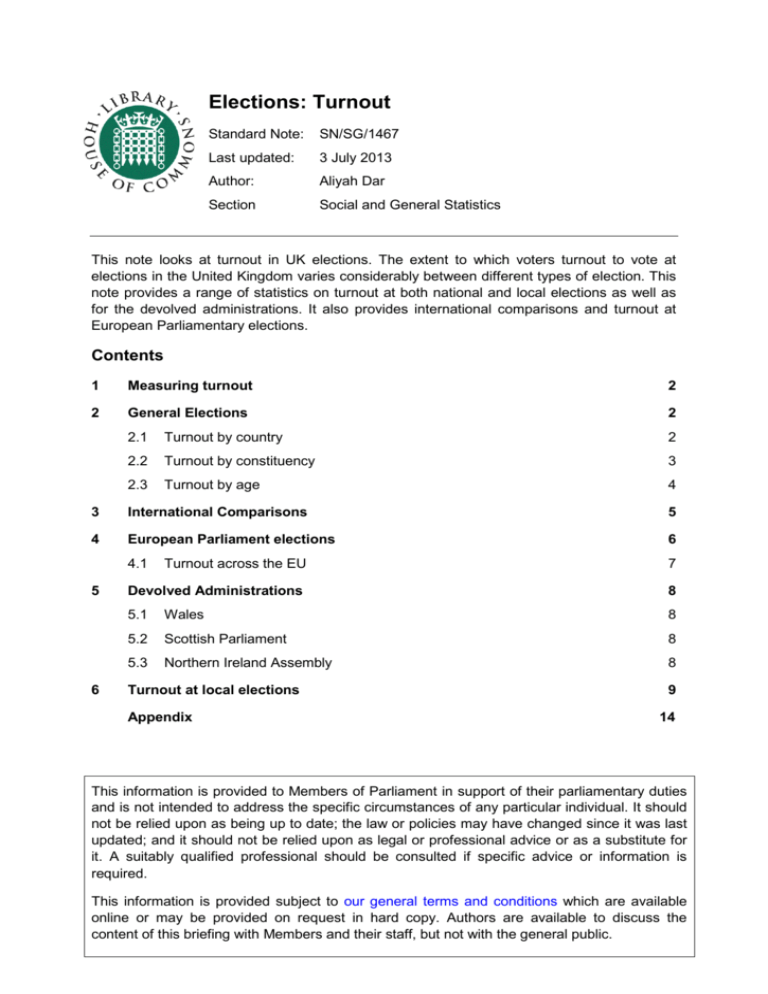
Elections: Turnout Standard Note: SN/SG/1467 Last updated: 3 July 2013 Author: Aliyah Dar Section Social and General Statistics This note looks at turnout in UK elections. The extent to which voters turnout to vote at elections in the United Kingdom varies considerably between different types of election. This note provides a range of statistics on turnout at both national and local elections as well as for the devolved administrations. It also provides international comparisons and turnout at European Parliamentary elections. Contents 1 Measuring turnout 2 2 General Elections 2 2.1 Turnout by country 2 2.2 Turnout by constituency 3 2.3 Turnout by age 4 3 International Comparisons 5 4 European Parliament elections 6 4.1 Turnout across the EU 7 Devolved Administrations 8 5.1 Wales 8 5.2 Scottish Parliament 8 5.3 Northern Ireland Assembly 8 5 6 Turnout at local elections Appendix 9 14 This information is provided to Members of Parliament in support of their parliamentary duties and is not intended to address the specific circumstances of any particular individual. It should not be relied upon as being up to date; the law or policies may have changed since it was last updated; and it should not be relied upon as legal or professional advice or as a substitute for it. A suitably qualified professional should be consulted if specific advice or information is required. This information is provided subject to our general terms and conditions which are available online or may be provided on request in hard copy. Authors are available to discuss the content of this briefing with Members and their staff, but not with the general public. 1 Measuring turnout Throughout this note turnout is defined where possible as the total number of valid votes as a proportion of the total electorate. Some election studies include spoilt and other invalid ballot papers when measuring turnout; this may account for any differences between the figures in this note and those published elsewhere. Comparative data on turnout can also be affected by the extent to which the eligible population registers to vote: the proportion of the population of voting age that casts a vote is less than the proportion of those on the electoral register. 2 General Elections Turnout at the most recent General Election in 2010 was 65.1%, an increase on the previous election but still the third lowest since 1945. The chart below shows the electorate (the proportion of people eligible to vote) and turnout as a proportion of those who chose to vote at UK General Elections since 1900 Chart 1: Turnout at General Elections in the UK 100 90 80 70 Turnout 60 50 40 30 20 Electorate 10 2010 2005 2001 1997 1992 1987 1983 1979 1974 1974 1970 1966 1964 1959 1955 1951 1950 1945 1935 1931 1929 1924 1923 1922 1918 1910 1910 1906 1900 0 Turnout tends to be low when the margin of victory of a General Election is high, suggesting that people are more inclined to vote if the result is uncertain. Turnout at the 2001 election was 59.4%, this was the first time that turnout had fallen below 70% since 1918. Turnout in 1918 was depressed in the wake of the First World War, whereas the 2001 election followed the Labour landslide victory of 1997. Turnout at subsequent General Elections has recovered from this low, but has remained under 70%. The highest recorded turnout for a General Election since 1900 was 86.8% in January 1910, when the franchise was limited to men aged over 21 who paid rates or owned. 2.1 Turnout by country The chart overleaf shows how turnout has varied between countries in the UK since 1900: 2 100 Chart 2: Turnout (%) in General Elections by Country, 1900 - 2010 90 England 80 Wales 70 Scotland 60 Northern Ireland 50 40 1900 1910J 1918 1923 1929 1935 1950 1955 1964 1970 1974O 1983 1992 2001 2010 Note: Prior to 1922 data for Northern Ireland includes the whole of Ireland At the 2010 election, turnout was highest in England. Until 2001, Wales generally had the highest turnout at General Elections. Northern Ireland has usually had lower turnout than the other countries although it reported the highest turnout in 2005. The full dataset for turnout by country can be found in appendix table A1 of this note. 2.2 Turnout by constituency Turnout at general elections can vary considerably between constituencies. The highest and lowest constituency turnouts in the 2010 general election were as follows: Table 1: Highest and lowest constituency turnouts Turnout 1 2 3 4 5 6 7 8 9 10 East Renfrew shire Westmorland and Lonsdale Richmond Park Winchester Central Devon North East Somerset St Albans Kenilw orth and Southam Thornbury and Yate East Dunbartonshire UK average 65.1% 641 642 643 644 645 646 647 648 649 650 Glasgow Central East Antrim Kingston upon Hull East Manchester, Gorton Thirsk and Malton Blackley and Broughton Glasgow North East Birmingham, Ladyw ood Leeds Central Manchester Central 50.9% 50.7% 50.6% 50.5% 49.9% 49.2% 49.1% 48.7% 46.0% 44.3% Source: HC Library, General Election 2010 3 77.3% 76.9% 76.2% 75.8% 75.7% 75.4% 75.4% 75.2% 75.2% 75.2% The highest turnout in the UK was 77% in East Renfrewshire, the lowest turnouts are mostly in urban areas. In six constituencies turnout was below 50%, the lowest turnout also included Thirsk and Malton where the poll was postponed. 1 Turnout across constituencies which elected a Conservative MP was 7.2% points higher than in areas with a Labour MP: Chart 3: Turnout by party winning in each constituency 80% 68.3% 70% 67.6% 61.1% 60.1% LAB OTH 60% 50% 40% 30% 20% 10% 0% CON 2.3 LD Turnout by age There are no official figures for voting by age, but a long-running academic study, the British Election Study, provides reasonably consistent survey-based data for General Elections since 1964: Table 2: Estimated percentage turnout by age at General Elections: 1964-2010 1964 1966 1970 F1974 O1974 1979 1983 1987 1992 1997 2001 2005 18-24 76.4 60.5 64.9 70.2 62.5 62.5 63.9 66.6 67.3 54.1 40.4 38.2 2010 51.8 25-34 70.7 70.8 66.5 77.2 69.0 72.4 67.6 74.0 77.3 62.2 45.0 47.7 57.3 35-44 79.5 80.0 72.8 78.7 73.9 76.3 76.2 74.9 78.3 70.2 55.7 61.6 64.4 45-54 79.1 79.8 74.9 73.1 76.6 81.2 77.6 79.9 81.8 76.4 63.2 65.5 67.5 55-64 78.4 78.0 74.1 82.2 76.6 81.4 77.2 78.9 78.1 79.9 64.0 72.6 69.8 65+ 76.7 75.9 77.2 79.2 76.0 77.7 73.1 76.0 79.2 77.7 70.1 74.3 74.7 All 77.1 75.8 72.0 78.8 72.8 76.0 72.7 75.3 77.7 71.4 59.4 61.3 65.0 Sources: British Election Study (re-analysis of datasets) HC Library Research Paper 03/59 Note: Data for 1964 and 1966 refers to people aged 21-24 as the voting age was 21 not 18 The decline in young people’s engagement in politics has been a common theme of late. As seen above, voter turnout has been low among young people relative to older age groups, but in the context of falling overall turnout at General Elections, the decline has been sharpest amongst voters aged 18-24: 1 Turnout figures for each constituency are available in the General Election 2010 House of Commons Library research paper, RP10/36. 4 Chart 4: Turnout by age at General Elections 18-24 All 100 90 80 70 60 50 40 30 20 10 0 1964 3 1966 1970 F1974 O1974 1979 1983 1987 1992 1997 2001 2005 2010 International Comparisons Turnout can be measured using two measures - as a proportion of the population who are of voting age and as a proportion of the population registered as an elector. The chart below shows both at the most recent national parliamentary elections in the EU27 and selected other countries: 2 Chart 5: International comparisons of turnout United Kingdom Lithuania Romania Hungary Poland Bulgaria France Portugal Slovakia Latvia Canada Greece Czech Republic Estonia United States Slovenia Finland Spain Ireland Germany New Zealand Netherlands Italy Cyprus Austria Sweden Denmark Belgium Luxembourg Malta Australia 0 10 20 30 40 Turnout as a % of voting age population 50 60 70 Turnout as a % of registered voters Source: International Institute for Democracy and Electoral Assistance (IDEA) 2 Data for the United States relates to the 2008 presidential election 5 80 90 100 When measuring turnout as a proportion of registered voters, fifteen countries had a higher turnout than the UK. However, caution is needed when making international comparisons as, in some countries such as Australia, voting is compulsory, and at the 2010 election, there was a turnout of 93%. Yet, when turnout is measured as a proportion of those of voting age it fell to 81%. In some countries such as the United States, a much lower proportion of the voting age population is registered to vote compared to most EU countries, including the UK. In some cases, turnout was higher as a share of the voting age population than as a share of registered voters. Although this may appear impossible, it’s likely to reflect difficulties maintaining an accurate electoral register given migration between districts, deaths etc. A full data series on international turnout can be found in the appendix of this note. 4 European Parliament elections Turnout at European Elections in the UK has been relatively low since 1979. Turnout in Northern Ireland where a system of Single Transferable Vote has operated in all European elections, has been significantly higher than the rest of the UK: Table 4: Turnout at European elections, 1979-2009 % of registered voters England Wales Scotland Northern Ireland United Kingdom 1979 31.8 34.4 33.6 55.6 32.7 1984 31.6 39.7 33.1 64.4 32.9 1989 35.8 41.1 40.8 48.3 36.8 1994 35.5 43.1 38.2 48.7 36.5 1999 22.7 28.1 24.7 57.0 24.0 2004 38.8 41.4 30.6 51.2 38.5 2009 35.1 30.4 28.5 42.4 34.5 Sources: Colin Rallings and Michael Thrasher, British Electoral Facts 1832 - 2012 HC Library, European Parliament elections 2009 The highest reported turnout at a European Parliament election in the UK was 38.5% in 2004; this followed a record low 24.0% turnout in 1999. Turnout again fell in 2009, but it was above the 1999 level. When comparing 2009 with 2004, turnout rose in only 3 regions – East, South East and South West. 6 Chart 6: UK turnout (%) in European Parliament elections by region, 2009 % change 2004-09 Scotland North East Wales North West Yorks & Humber London UK West Midlands England East Midlands South East East South West Northern Ireland 0 4.1 10 20 30 40 50 -20 -10 0 10 Turnout across the EU Turnout in the UK at European Parliament elections has been consistently low when compared with other EU countries. In the most recent European Parliament elections, turnout in the UK was higher than that of six other member states including Slovakia where fewer than one-in-five electors voted: Table 5: Turnout for European Parliament elections Proportion of registered voters Luxemburg Belgium Malta Italy Denmark Cyprus Ireland Latvia Greece Austria Sweden Spain Estonia Germany France Finland Bulgaria Portugal Netherlands Hungary UK Slovenia Czech Republic Romania Poland Lithuania Slovakia EU average 1979 88.9 91.4 1984 88.8 92.1 1989 87.4 90.7 1994 88.6 90.7 1999 87.3 91.1 85.7 47.8 82.5 52.4 81.1 46.2 73.6 52.9 69.8 50.5 63.6 47.6 68.3 44.0 50.2 80.6 80.0 73.2 54.7 59.1 70.3 49.4 38.8 63.1 65.7 60.7 56.8 56.7 62.3 48.8 60.0 52.7 45.2 46.8 30.1 58.1 50.9 51.1 47.5 35.5 35.7 39.9 30.0 32.4 32.6 36.4 36.4 24.0 62.0 59.0 58.4 56.7 49.5 2004 91.4 90.8 82.4 71.7 47.9 72.5 58.6 41.3 63.2 42.4 37.9 45.1 26.8 43.0 42.8 39.4 20.9 48.4 17.0 2009 90.8 90.4 78.8 65.1 59.5 59.4 58.6 53.7 52.6 46.0 45.5 44.9 43.9 43.3 40.6 40.3 39.0 36.8 36.8 36.3 34.7 28.3 28.2 27.7 24.5 21.0 19.6 45.5 43.0 38.6 39.3 38.5 38.5 28.4 28.3 Source: European Parliament, Turnout at European Parliament elections Note: Shaded area indicates that the country was not part of the EU in the year of the particular election 7 As the table above shows, turnout has declined in most EU countries since 1979, overall, the lowest turnout reported was 43% in 2009. 5 Devolved Administrations Elections for the devolved administrations first took place in 1998. 5.1 Wales Elections to the National Assembly for Wales (NAW) were first held in May 1999. Elections to the NAW are conducted using the Additional Member System. Under this system, voters have two votes; one to elect a constituency member and one for a party on a regional list: Table 6: Turnout in the National Assembly for Wales elections Regional list Constituencies 1999 46.3% 46.4% 2003 38.1% 38.2% 2007 43.4% 43.5% 41.4% 41.5% 2011 Sources: Colin Rallings and Michael Thrasher, British Electoral Facts 1832 - 2012 HC Library, UK election statistics: 1918-2012 Turnout in both the regional list and constituency vote was highest in 1999, turnout in 2011 for both of them was around 41%, a decrease compared to 2007 but higher than 2003. 5.2 Scottish Parliament Elections to the Scottish Parliament were also held for the first time in May 1999 and are conducted using the Additional Member system: Table 7: Turnout in the Scottish Parliament elections Regional list Constituencies 1999 58.7% 58.8% 2003 49.4% 49.4% 2007 52.4% 51.7% 50.4% 50.4% 2011 Sources: Colin Rallings and Michael Thrasher, British Electoral Facts 1832 - 2012 HC Library, UK election statistics: 1918-2012 Like the NAW elections the highest reported turnout for Scottish Parliament elections was in the inaugural 1999 election, although turnout has generally been at around the 50% mark in all subsequent elections. 5.3 Northern Ireland Assembly Elections to the Northern Ireland Assembly were first held in 1998. Members are elected using the Single Transferable vote: 8 Table 7: Turnout in the Northern Ireland Assembly elections 1998 70.0 2003 64.0 2007 62.9 2011 55.7 Source: British Electoral Facts 1832 - 2012 Turnout at the Northern Ireland Assembly elections has typically been higher than the devolved elections in Scotland and Wales. In 1998, turnout was 70.0%, however, this fell to 54% by the latest election in 2011. 6 Turnout at local elections The tables and charts below show turnout at local elections in the UK since 1973. There are a number of problems associated with assessing turnout at local elections not least multimember wards and non-contestation. Local authorities may also be inconsistent in their treatment of attainers. Turnout may have been higher than reported in the 1970’s, as the electoral register was not kept fully up to date as it was expensive and time consuming to do so. Despite some problems in the data, it is clear to see that turnout for elections in London boroughs is generally higher than those in Metropolitan districts. Also, when an election coincides with a General Election, turnout is significantly higher: Chart 7: Turnout at local elections as a percentage of total electorate in England London boroughs 1974 36.3 1978 42.9 1982 43.9 1986 45.5 1990 48.1 1994 46.0 1998 34.6 2002 31.6 2006 39.9 2010 61.4 80 60 40 20 0 1973 1979 1985 1991 1997 2003 2009 9 Unitaries 1995 40 1996 35 1997 70 1998 28 1999 32 2000 29 2001 58 2002 30 2003 37 2004 37 2005 61 2006 34 2007 36 2008 35 2009 42 2010 61 2011 40 2012 30 80 60 40 20 0 1995 1999 10 2003 2007 2011 Metropolitan districts 1973 33 1975 33 1976 38 1978 37 1979 75 1980 36 1982 39 1983 42 60 1984 41 1986 40 40 1987 45 1988 40 1990 46 1991 41 1992 33 1994 39 1995 34 1996 31 1998 25 1999 26 2000 26 2002 32 2003 33 2004 41 2006 35 2007 35 2008 34 2010 61 2011 38 2012 31 80 20 0 1973 1980 11 1987 1994 2001 2008 Non - metro districts 1973 39 1976 44 1978 42 1979 77 1980 39 1982 42 1983 46 1984 40 1986 42 1987 48 1988 42 1990 49 1991 48 1992 38 1994 43 1995 41 1996 37 1998 31 1999 36 2000 32 2002 35 2003 36 2004 41 2006 37 2007 38 2008 36 2010 66 2011 44 2012 31 80 60 40 20 0 1973 1980 12 1987 1994 2001 2008 Scottish unitaries 1974 52 1977 48 1980 46 1984 45 1988 46 1992 41 1995 45 1999 59 2003 50 2007 53 2012 40 80 60 40 20 0 1973 1980 1987 1994 2001 2008 Note: Districts until 1995 Northern Ireland districts 1981 66 1985 60 1989 56 1993 57 1997 55 2001 69 2005 63 2011 56 80 60 40 20 0 1981 1989 13 1997 2005 Appendix Table A1: Turnout (%) in General Elections by country, 1900 - 2010 England Wales Scotland Northern Ireland UK 1900 76.0 76.4 75.3 60.9 75.1 1906 83.6 82.6 80.9 82.1 83.2 1910 (Jan) 87.7 84.9 84.7 80.3 86.8 1910 (Dec) 82.1 78.3 81.8 47.8 81.6 1 1918 55.7 65.9 55.1 69.5 57.2 19222 72.8 79.4 70.4 77.2 73.0 1923 71.1 77.3 67.9 76.5 71.1 1924 77.4 80.0 75.1 66.7 77.0 3 1929 76.6 82.4 73.5 63.8 76.3 1931 76.1 79.3 77.4 74.5 76.4 1935 70.7 76.4 72.6 72.0 71.1 1945 73.4 75.7 69.0 67.4 72.8 1950 84.4 84.8 80.9 77.4 83.9 1951 82.7 84.4 81.2 79.9 82.6 1955 76.9 79.6 75.1 74.1 76.8 1959 78.9 82.6 78.1 65.9 78.7 1964 77.0 80.1 77.6 71.7 77.1 1966 75.9 79.0 76.0 76.1 75.8 4 1970 71.4 77.4 74.1 76.6 72.0 1974 (Feb) 79.0 80.0 79.0 69.9 78.8 1974 (Oct) 72.6 76.6 74.8 67.7 72.8 1979 75.9 79.4 76.8 67.7 76.0 1983 72.5 76.1 72.7 72.9 72.7 1987 75.4 78.9 75.1 67.0 75.3 1992 78.0 79.7 75.5 69.8 77.7 1997 71.4 73.5 71.3 67.1 71.4 2001 59.1 61.4 58.1 68.0 59.4 2005 61.3 62.6 60.8 62.9 61.4 2010 65.5 64.8 63.8 57.6 65.1 Sources: Colin Rallings and Michael Thrasher, British Electoral Facts 1832 - 2012 Notes: 1 HC Library, General Election 2010 Those who served in the war were enfranchised at 19 years of age. Women were enfranchised at 30 years of age 2 Prior to 1922 data for Northern Ireland includes the whole of Ireland 3 Extention of the franchise to women aged 21 4 Extention of franchise to all people aged 18 14 Table A2: International comparisons of turnout Voter turnout Registered Voting age as a % of registered voters as a % of population as a population % voters Australia Austria Belgium Bulgaria Canada Cyprus Czech Republic 1998 95.0 64.8 74.9 2001 94.9 65.9 74.2 2004 94.3 65.8 75.3 2007 94.8 66.8 76.8 2010 93.2 65.5 75.3 1995 86.0 71.3 78.0 1999 80.4 71.6 79.2 2002 84.3 72.5 78.9 2006 78.5 74.6 79.9 2008 81.7 74.4 80.4 1995 91.1 71.2 78.0 1999 90.6 72.0 78.4 2003 91.6 73.7 78.6 2007 91.1 74.3 78.7 2010 89.2 74.5 71.3 1997 58.9 87.5 77.0 2001 66.6 87.2 80.6 2005 55.8 90.2 80.6 2009 60.6 99.0 82.8 2013 52.5 95.0 83.6 2000 61.2 68.1 76.2 2004 60.9 69.8 76.9 2006 64.9 69.5 77.3 2008 59.5 70.5 78.3 2011 61.4 70.4 80.4 1991 94.3 59.7 71.6 1996 90.1 54.7 65.0 2001 91.8 60.2 71.2 2006 89.0 63.9 73.1 2011 78.7 47.4 79.1 1996 76.3 77.3 76.0 1998 74.0 78.9 76.1 2002 57.9 80.5 79.0 2006 64.5 81.4 80.6 2010 62.6 82.5 83.0 15 Table A2: International comparisons of turnout (continued) Voter turnout Registered Voting age as a % of registered voters as a % of population as a population % voters Denmark Estonia Finland France Germany Greece Hungary 1998 85.9 76.4 79.0 2001 87.1 74.7 77.2 2005 84.5 74.0 76.9 2007 86.6 73.6 76.6 2011 87.7 73.8 79.1 1995 68.9 53.2 75.0 1999 57.4 60.6 75.7 2003 58.2 60.7 73.5 2007 61.9 68.2 79.0 2011 63.5 71.2 81.6 1995 68.6 79.9 77.0 1999 65.3 80.2 80.2 2003 66.7 81.4 77.6 2007 65.0 82.1 78.2 2011 67.4 83.4 80.2 1993 68.9 67.6 76.0 1997 68.0 66.9 76.0 2002 60.3 61.8 78.8 2007 60.0 55.3 76.4 2012 55.4 65.9 79.2 1994 79.0 74.3 81.0 1998 82.2 73.9 80.7 2002 79.1 74.0 79.7 2005 77.7 75.1 81.0 2009 70.8 76.0 83.2 2000 75.0 90.6 76.3 2004 76.6 92.7 81.0 2007 74.1 92.7 86.3 2009 70.9 92.5 82.8 2012 62.5 92.4 83.2 1994 55.1 76.7 77.0 1998 57.0 79.7 77.0 2002 73.5 58.4 77.8 2006 64.4 50.2 78.7 2010 46.7 24.9 81.3 16 Table A2: International comparisons of turnout (continued) Voter turnout Registered Voting age as a % of registered voters as a % of population as a population % voters Ireland Italy Japan Latvia Liechtenstein Lithuania Luxembourg 1992 68.5 72.0 67.0 1997 65.9 72.0 70.4 2002 62.6 78.2 73.0 2007 67.0 73.5 71.5 2011 70.1 68.6 75.3 1996 82.9 85.3 81.0 2001 81.4 85.6 82.1 2006 83.6 80.9 82.4 2008 80.5 81.0 82.5 2013 75.2 76.3 84.0 2000 60.6 79.1 81.2 2003 59.8 80.4 81.4 2005 67.5 80.9 81.9 2009 69.3 81.8 81.7 2012 59.3 81.6 81.1 1998 71.9 55.2 76.4 2002 71.2 58.6 75.7 2006 61.0 65.5 79.6 2010 64.7 67.3 83.0 2011 59.5 70.0 83.4 1997 86.9 46.1 74.5 2001 86.7 50.8 77.6 2005 86.5 50.8 76.3 2009 84.6 53.2 79.7 2013 79.8 52.4 79.4 1996 52.9 69.9 74.0 2000 58.2 72.1 83.1 2012 35.9 81.7 82.1 2004 40.2 68.9 78.5 2008 32.4 72.4 79.6 1989 87.4 57.9 79.0 1994 88.3 54.1 79.0 1999 86.5 51.4 78.2 2004 91.7 47.9 77.7 2009 90.9 45.5 77.8 17 Table A2: International comparisons of turnout (continued) Voter turnout Registered Voting age as a % of registered voters as a % of population as a population % voters Malta Netherlands New Zealand Poland Portugal Romania Slovakia Slovenia 1996 97.2 73.6 73.0 1998 95.4 74.1 73.7 2003 95.7 75.0 75.2 2008 93.3 78.5 82.4 2013 93.0 81.3 82.4 2002 79.1 75.3 77.5 2003 80.0 72.7 75.1 2006 80.4 74.4 77.1 2010 75.4 74.6 79.1 2012 74.6 75.8 79.6 1999 84.8 65.5 73.0 2002 77.0 69.1 73.4 2005 80.3 70.6 71.5 2008 79.5 71.7 73.2 2011 74.2 71.6 76.1 1997 47.9 73.3 72.0 2001 46.2 76.0 73.7 2005 40.6 78.2 77.7 2007 53.9 79.5 79.0 2011 48.9 81.5 82.1 1999 61.0 89.0 78.4 2002 62.8 88.2 80.8 2005 64.3 85.0 78.9 2009 59.7 88.9 80.2 2011 58.0 81.2 82.7 1996 76.0 76.1 74.0 2000 65.3 79.4 83.4 2004 58.5 82.5 77.6 2008 39.2 83.7 81.1 2012 41.8 84.3 82.3 1998 84.2 76.3 81.5 2002 70.1 77.3 75.6 2006 54.7 78.5 76.1 2010 58.8 79.7 80.4 2012 59.1 80.1 81.9 1996 73.7 79.2 77.0 2000 70.4 79.8 77.6 2004 60.6 81.3 80.7 2008 63.1 84.5 82.0 2011 65.6 85.5 83.7 18 Table A2: International comparisons of turnout (continued) Voter turnout Registered Voting age as a % of registered voters as a % of population as a population % voters Spain 1996 78.1 81.5 79.0 2000 68.7 86.2 80.3 2004 75.7 81.6 81.0 2008 76.0 74.8 81.3 2011 68.9 76.1 82.9 1994 86.8 74.0 78.0 1998 81.4 75.2 78.8 2002 80.1 75.7 77.7 2006 82.0 75.9 77.2 2010 84.6 78.5 80.4 United Kingdom 1992 77.8 74.6 77.0 1997 71.5 74.8 77.0 2001 59.4 74.7 77.1 2005 61.4 73.4 77.2 2010 65.8 73.1 78.8 2004 68.7 60.5 73.4 2008 64.4 62.7 70.2 2012 n/a n/a 77.0 Sweden United States Source: International Institute for Democracy and Electoral Assistance, IDEA 19
